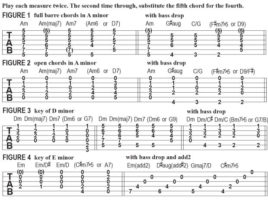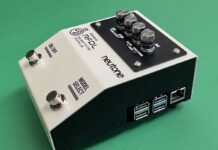
The Standard Minor-Drop Progression
In this lesson and the next, I’m going to cover an old musical staple, a familiar-sounding four-chord progression that has an endearing, poignantly sentimental quality that tugs on some people’s heart strings and has, with variations, been used and abused by many songwriters over the past 80 years (especially during the Sixties and Seventies), and I’ll present a variety of ways to play it on the guitar. We’ll start by identifying various incarnations of the progression and examples of its use in popular music, and in the next lesson, I’ll show you some fun ways to outline it melodically.
The progression is called the minor drop, and like stock blues turnarounds and other familiar moves that countless songwriters have “borrowed,” it has become an enticingly useful musical cliché. It begins on a minor chord, the root note of which then descends, or “drops,” chromatically (one fret at a time) while the other chord tones remain stationary. (This is an example of what music theoreticians called oblique voice-leading.)
The introductions to Led Zeppelin’s “Stairway to Heaven,” the Beatles’ “Michelle” and Tom Petty’s “Into the Great Wide Open” are but a few of many well-known examples of this signature move, performed in the keys of A minor, F minor and E minor, respectively.
Other famous songs from the twentieth century that incorporate the minor drop, in varying keys, in each instance used as part of a longer progression, are Pink Floyd’s “Shine on You Crazy Diamond,” the old jazz standard “My Funny Valentine,” “This Masquerade” by Leon Russell, “Veronica” by Elvis Costello, Stevie Wonder’s “For Once in My Life” and “I Just Called to Say I Love You,” “Gentle on My Mind” (famously covered by Glen Campbell), the Beatles’ “Something,” “All My Loving” and “Got to Get You Into My Life,” “Secret O’ Life” by James Taylor, the Bee Gees’ “You Should Be Dancing,” Emerson Lake and Palmer’s “C’est La Vie,” “Time in a Bottle” by Jim Croce, “After the Lovin’ ” (popularized by Engelbert Humperdinck), “My Way” (famously covered by both Frank Sinatra and Elvis Presley) and, probably the “schmaltzy-est” love song ever, “Feelings” (recorded by Morris Albert).
FIGURES 1–4 illustrate several sets of voicings and fingerings for the minor drop progression, presented in a variety of mostly theory-friendly keys, such as A minor, E minor and D minor, with a few common variations included. It’s worth noting that, with the minor-drop progression, the names of the second, third and fourth chords depend on what the bass line does, meaning whether it stays on the initial minor chord’s root, as a pedal tone, beneath the changes, resulting in a minor triad followed by a minor major-seven chord, a minor seven and then a minor six, respectively, or follows the chromatically descending line, in which case there’s no acknowledgement of the original chord’s name in the subsequent ones, so you have a minor chord followed by an augmented triad a half step lower, then a second-inversion major triad and a minor seven flat-five chord.
In either case, composers will oftentimes, after the first three chords, resolve the starting chord’s root note down a fifth (or up a fourth) to a major, dominant seven or dominant nine chord, with the fourth note of the descending line becoming that chord’s major third. The D/F# in the “Stairway” intro is a prime example of this move.
A common and effective use of the minor drop is to apply it to the ii (two) minor chord in a major key and use it as a means of prolonging and decorating a ii-V-I (two-five-one) progression, which is how it’s employed in “Gentle on My Mind,” “My Way” and both Stevie Wonder songs cited earlier. And it’s also common to instead change direction after the third chord and backtrack to the minor major-seven, which many people, myself included, find to be the most intriguing and bittersweet-sounding chord in the progression. “I Just Called to Say I Love You” and “You Should Be Dancing” are two examples of songs in which this retrograde move occurs.
Try transposing these sets of voicings that don’t include any open strings, to other keys and positions, to expand your musical vocabulary and working knowledge of chords and fretboard shapes. Next time, I’ll show you some fun, shred-y ways to arpeggiate the minor-drop progression that work well with distortion.
Source: www.guitarworld.com







